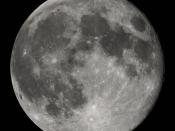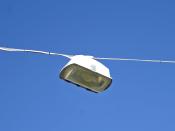Rhapsody on a windy night was written directly after Preludes and echoes many of its themes. Rhapsody... charts the night-time journey of a man through the streets of a city. Held in a trance by the moonlight, he is shown various sights by the street lamps he passes, and these sights evoke images, feelings and recollections. From the sights revealed by the lamps, and the responses they induce, a portrait of the city life is painted.
The poem begins by establishing the scene. A man is wandering "Along the reaches of the street / held in a lunar synthesis". Although the street is reaching, as if to entrap the man, it is held in stasis by the moon. This idea of the moon having power to release the wandering man from his everyday pattern of thought, from the "conscience of the blackened street", prevails throughout the poem. But it is not just the day-to-day considerations that the moon expels: "memory" too is dissolved, with all its "clear relations / Its divisions and precisions".
The metaphor of "dissolve[ing]...floors" suggests that memory was a platform, which is being wiped away - the man is left floating in space.
The lines
Every street lamp that I pass
Beats like a fatalistic drum
have a number of possible implications. One possibility is that the passing lamps remind the man of the passing time, and that soon he will be home, and forced out of the "lunar synthesis". This interpretation is supported by the references to the time at the beginning of each stanza. The lines "Half-past one...Half-past two...Half-past three", are like the beating of a drum, and a fatalistic one in that the progress of time is inexorable. Alternatively, the lines could be emphasising the fear and fatalism inherent in the visions revealed...


